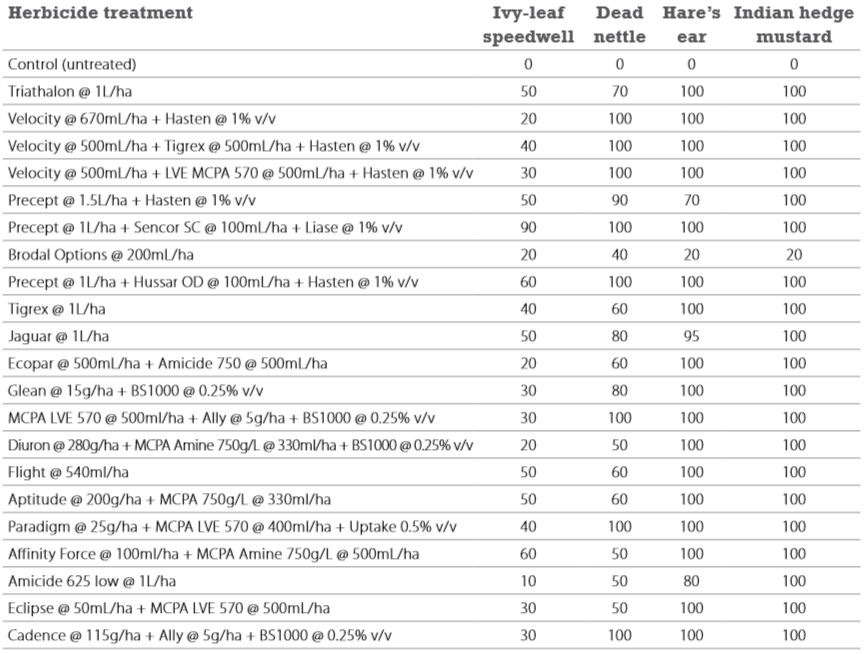Take home messages
- Metribuzin added to Precept® gave good control of all weeds.
- Affinity Force® did not perform to the standard expected.
Background
Ivy-leaf speedwell is not a very common weed in a continuous cropping situation. There is little knowledge of which herbicides can control it. With a dense population of ivy-leaf speedwell, the Horsham site presented a good opportunity to evaluate a range of new and current herbicide mixes to determine which products would be effective.
Within the trial area, other weeds were also present including dead nettle, hare’s ear and Indian hedge mustard, adding greater value to the trial.
Note: Some of the herbicides tested in this demonstration were not registered for use at the rates they were applied, and were used only for research purposes. Any off-label use of herbicides is the user’s responsibility, including residue control, environmental safeguards, occupational health and safety and animal welfare.
Aim
To identify the most effective herbicide product and mixes to control hard-to-kill broadleaf weeds in the Wimmera.
Trial details
Location: Horsham
Soil type: Heavy clay
GSR (Apr-Oct): 125mm
Crop type: Fallow
Spray application date: 20 August
Weather details: See Table 1
Herbicides: See Table 2
Weed growth stage: Ivy-leaf speedwell: 5-10cm in diameter
Indian hedge mustard: rosette 10-15cm
Hare’s ear (wild cabbage, treacle mustard): 5-10cm
Dead nettle: 5-10cm long
Weed population: Dense stand of ivy-leaf speedwell and dead nettle. Sporadic hare’s ear and Indian hedge mustard
Assessment date: 25 September (36 days after application (DAA))
Table 1. Spraying conditions at time of application.
Table 2. Herbicide treatments and their herbicide groups in the trial.
Method
The paddock was selected on the basis of its dense population and even distribution of ivy-leaf speedwell and the trial was established in a fallow area of the Horsham site. The trial was sprayed using two replicates to account for any variation.
The top soil was dry, with limited moisture below when the treatments were applied. The weeds were moderately stressed when spraying occurred. There was no major rainfall event after the trial was sprayed.
Application of some of the herbicides used in this situation was off-label and spraying at this stage and weed size may have had a bearing on the performance of some of the herbicides.
The trial was sprayed at a high water rate of 100L/ha to achieve best possible coverage. Estimated percentage weed reduction and control was visually scored 35 DAA.
Results and interpretation
As seen in Table 3, below, not many of the herbicides were effective against the ivy-leaf speedwell. The only outstanding herbicide brew with activity was the Precept (pyrasolfotole and MCPA) + Sencor SC® (metribuzin) + Liase (ammonium sulfate) mixture. The addition of metribuzin to Precept increased efficacy on all the weeds. The pyrasolfotole and MCPA alone together were not very effective on the weed. This can also be seen in the Velocity + MCPA LVE brew.
It was expected that the Affinity Force mix would do a much better job on the ivy-leaf speedwell and dead nettle, especially at the highest label rate. Having no crop competition may have allowed for the weeds to grow back more easily than they would in a crop situation. In the other trials around the site the same brew was used and achieved close to 100% kill.
The herbicides with the most effect on dead nettle were the group B and I mixtures such as Ally, Paradigm and Cadence. Eclipse plus MCPA did not perform as well as the other group B and I mixtures. Velocity and Precept were also effective on this weed. Precept was assisted by the inclusion of metribuzin or Hussar to gain full control. This was followed by the group C, F and I herbicide mixtures which include herbicides such as Flight, Triathlon, Jaguar and Tigrex. The herbicides which worked well were the systemic chemicals that slowly killed the plant. Contact herbicides that burned off the leaf, allowed the plant to subsequently put out new growth and survive.
Most of the herbicides did a very good job on the hare’s ear and Indian hedge mustard. The worst performer was Brodal (Group F), which has the active ingredient of diflufenican, which is also a major component of Tigrex. Tigrex had a very good percentage control, which can be attributed to the MCPA component.
Table 3. Herbicide treatments and their control expressed as a visual per cent (%) control reduction from the untreated for each of the herbicide treatments at 36 DAA. Statistics were not performed due to this only being a screening trial.
Commercial practice
If spraying in a cereal crop situation, the Ally plus MCPA LVE would be a good, cost effective option to control dead nettle, hare’s ear and Indian hedge mustard. If the paddock contained ivy-leaf speedwell then metribuzin could be added to the mixture.
Affinity Force plus amine could also be another option for the in-crop use in cereals. It could come with some initial bleaching of the crop leaf but recovery should occur within two to three weeks of application. Caution should be used in the application of this chemical as frost events could increase the risk of crop damage.
If in a pulse cycle of the rotation, herbicide options to control these weeds may be limited. Herbicides such as simazine, atrazine, metribuzin, and Balance® may be used pre-emergent. After emergence, options are limited to herbicides such as Brodal, which is shown to have low control. To achieve the best results, spray early on small weeds as Brodal acts on the growing point of the plant.
Clearfield tolerant crops could also be an option with the use of On-duty® and Intervix®. These herbicides were not included in the trial but as other group B herbicides were successful, it is assumed that they could well be as effective.
Acknowledgements
This research was funded by the GRDC as part of the ‘Improving IWM practices in the Southern region – emerging weeds’ project (FR_UA00134) and by BCG members through their membership.



